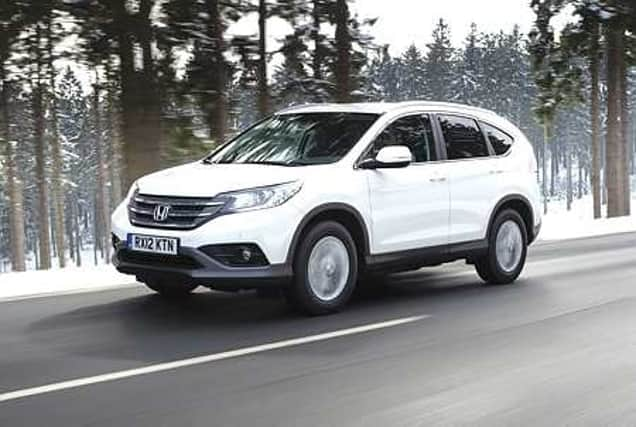Honda CR-V 1.6 i-DTEC SE-T


Honda CR-V 1.6 i-DTEC SE-T
Engine: 1,597cc, four-cylinder, turbodiesel
Power: 120bhp and 221lb.ft. of torque
Performance: 0-62mph in 11.2 seconds and 113mph
Economy: 62.8mpg (combined)
CO2 emissions: 119g/km
Price: £25,425
It just goes to show how your first idea may not always be your best.
In the case of Honda, the innovation-led Japanese manufacturer which trades in everything from lawn-mowers to robots and private jets, things were slightly different.
Advertisement
Hide AdAdvertisement
Hide AdKeen to exploit the success of its popular and reliable iVTEC petrol engines and passion for technology, it has been pioneering hybrid power as its favoured option for frugal drivers for more than a decade.
Now it seems that it may well be the creation of a more conventional, super-frugal diesel engine that is capable of winning it some hard-earned sales success.
Earlier this year I was wowed by Honda’s new 1.6-litre i-DTEC unit as the trip computer on my Civic hatchback test car tipped over the far side of 70mpg.
After a week’s driving with various levels of enthusiasm that figured levelled out in the low 60s, but the combination of frugality and surprisingly perky performance from the 118bhp (and 221lb.ft. of torque) motor had me won over.
Advertisement
Hide AdAdvertisement
Hide AdAfter Honda announced that it would be slotting the same engine into its considerably larger CR-V SUV I simply had to find out how it stood up to the added weight.
The two-wheel-drive CR-V 1.6 i-DTEC SE-T tested here (£25,425) is some 113kg heavier than the Civic but at a claimed 1,541kg it is far from being a heavyweight given its ample proportions.
Shedding four-wheel-drive and the larger 2.2-litre i-DTEC unit saves a total of 116kg over CR-V’s with Honda’s slightly older, larger, diesel engine and goes some way to redressing the balance of a 30bhp and 37lb.ft. power deficit.
In a straight line that means that the 1.6 i-DTEC can still reach 62mph from a standing start in a fairly respectable 11.2 seconds and power on to a 113mph top speed while returning headline fuel economy and CO2 emissions claims of 62.8mpg and 119g/km, respectively.
Advertisement
Hide AdAdvertisement
Hide AdWhat makes the combination of the little diesel engine and the CR-V such a success on the road — and it was a similar case in the Civic — is the excellent responses of its controls, and the six-speed manual gearbox in particular.
Freely flicked around the gate with an effortlessly smooth action it complements the fairly free-revving oil burner perfectly.
While the i-DTEC can operate at low revs, meaningful acceleration requires revs and it may occasionally be necessary to down-shift on steep inclines and on long motorway climbs where the 2.2 version would remain within its comfort zone.
Engine noise rises with the revs but is never overly intrusive.
Advertisement
Hide AdAdvertisement
Hide AdDespite the CR-V’s lofty ride height and loss of four-wheel-drive traction, understeer was not the problem I anticipated it might be and the busy, slightly over-firm suspension of the Civic is replaced by a more compliant compromise.
Key among the CR-V’s rivals are Mazda’s equally low-emitting but quicker and more nimble CX-5 and the slightly less frugal but well-built and more accelerative Toyota Rav4.
But neither matches the CR-V in terms of sheer scale and spacious interior accommodation.
While I received comments that the Honda’s seats were on the firm side of comfortable, space was never an issue for four adults and a cavernous 589 litre boot makes it fantastically practical family transport.
Advertisement
Hide AdAdvertisement
Hide AdHonda’s use of hard plastics which lack the soft-touch tactility of its rivals continues and while build quality feels good, with all controls positive in their engagement, this means the interior isn’t the cosy, cosseting environment it could be.
Among the standard kit on the mid-range SE-T model tested here (the T indicating the £765 addition of integrated sat-nav) is sat-nav, front and rear parking sensors and rear view camera, cruise control, automatic lights and wipers, Bluetooth hands-free phone connectivity and cruise control.
Strangely, the optional addition of sat-nav sees the removal of an otherwise standard DAB radio.
I truly enjoyed my week with the CR-V 1.6 i-DTEC and concluded that its real-world fuel economy (I barely dipped below 50mpg), sheer wealth of accommodation and enjoyable engine and gearbox combination made it the pick of the current line-up.
Advertisement
Hide AdAdvertisement
Hide AdFurthermore, as a family run-about it has the beating of both the Rav4 and CX-5.
The Mazda might be a more exciting steer — and offer more style, to my eyes — but in this class the CR-V’s range of abilities will count for more with potential owners.
It might not use futuristic hybrid technology but it does feel as though Honda have hit the nail on the head by mating the smaller i-DTEC engine to their commodious SUV